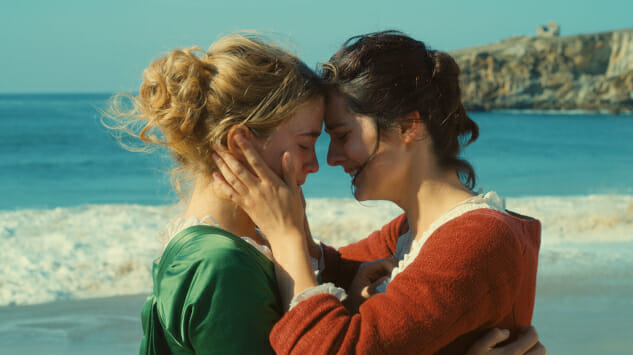Music’s Visceral, Pivotal Role in Portrait of a Lady on Fire
Céline Sciamma’s exquisite film doesn’t have a score, but that makes the rare brush with melody all the more powerful
Image via MK2 Music Features Portrait of a Lady on Fire
The run time of Céline Sciamma’s pristine Portrait of a Lady on Fire is just over two hours, so it was surprising to sit in the theater for that hefty block of time and never hear long stretches of music accompanying the action. The actors’ steady breaths were the only consistent background noise. Sciamma forwent original compositions for this, her fourth full-length picture, which takes place in the late 18th century, and it proved to be a smart move. We hear music only a handful of times throughout the movie, and each instance underlines an intense emotional moment between the painter Marianne (Noémie Merlant) and her hesitant subject/eventual lover Héloise (Adèle Haenel). Watching those sharp scenes arrive in a film otherwise devoid of a conventional score was a skin-tingling experience.
Shortly after Marianne arrives, under the guise of a hired companion, at the isolated island in Brittany where she has been charged with secretly painting the hot-headed Héloise’s wedding portrait, the pair take to the cliffs for a stroll. Finally free of her mother’s tight leash, Héloise, whose sister has just died via flinging herself from those same cliffs, bolts straight for the craggy bank. She stops right before the edge and says something about how she’s always dreamed of that exact moment.
Fearing Héloise to be suicidal like her sister, Marianne asks, “Mourir?” (“Dying?”).
Héloise replies: “Courir” (“Running”).
Outside of those two lines acting as a perfectly devastating rhyme, this is also the moment when we begin to fully realize how isolated Héloise is. A recovering nun and a resistant bride-to-be, she later tells Marianne the thing she misses most about the convent is the music. Marianne makes a comment about how organ music is a bit drab and asks Héloise if she has ever been to the orchestra. She hasn’t. Marianne (the truest definition of a Renaissance woman) sits down at the nearby harpsichord and begins to play Vivaldi’s Violin Concerto. The two women—not yet together at this point—are slowly becoming closer in both the physical and emotional senses of the word. Later, Sciamma ends the movie with a profound ode to this moment and to the love story it represents as Héloise, years after the film’s events, is overwhelmed by an orchestra’s performance of that same song. It’s one of the most visceral final scenes in a film I’ve ever seen.
The other major musical moment occurs just after the halfway mark of the movie, when Marianne and Héloise attend an all-girls bonfire somewhere deep in the forest of this island (Extroverts will have FOMO watching). At this point, Marianne and Héloise are still exchanging nothing more than longing looks, and their desire is cresting. All of sudden, the other attendees share excited glances before gathering around the flames to sing a truly eerie a capella arrangement in the round. The stark “La Jeune Fille en Feu,” which features flamenco-like claps and oodles of harmonies, is not exactly a historically accurate piece (as Matthew Dessem noted at Slate), but that’s because it was written especially for the film. Sciamma told IndieWire she researched 18th century music but never came across anything that would fit her specific vision for the scene. She wrote the lyrics herself, and her Tomboy collaborator/electronic producer Para One wrote the music with Arthur Simonini. It’s utterly shocking to hear the strange chant after more than an hour of almost no music at all, but that’s what makes it so timely.
In that same interview, Sciamma said the scene represented sisterhood (two things Marianne and Héloise are lacking, until they form their own little sorority with house maid Sophie). The Latin lyrics “fugere non possum” translate to something like “I cannot flee away.” Both of our protagonists are feeling this uninvited grounding in one way or another—Héloise is trapped in an arranged engagement, where Marianne is a female artist trying to make her way in a man’s industry. At one point, she divulges to Héloise that she is permitted to paint women in the nude, but must take the naked likeness of men in secret (and even that is merely “tolerated”). She submits paintings to museums under her father’s name.
But in that starlit moment of sisterhood—and in Marianne’s and Héloise’s forbidden but revitalizing relationship—they’re truly seen. Portrait of a Lady on Fire is an 18th century lesbian romance (and it very often looks exactly like what you’d expect of such a film), but it’s also radical in its use of sound and light. The deliberate lack of music works to highlight what’s really at stake here: Two women’s agency, and protecting their staggering love for one another.